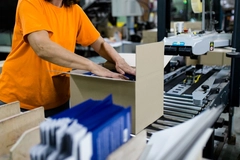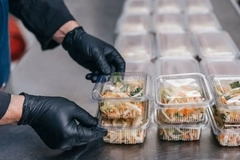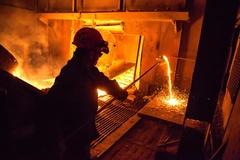Packagers leverage automation and robotics to bridge production quality and efficiency gap

Automation and robotics have become essential for businesses striving to remain competitive in today’s fast-evolving packaging landscape. With increasing material diversity and a growing focus on environmental sustainability, intelligent machinery can unlock greater efficiency, precision, and long-term success.
Packaging industry leaders are moving toward smarter and more energy-efficient solutions. Enhanced connectivity through Industrial Internet of Things (IIoT) and advanced robotics for precision handling are shaping the future, according to industry experts.
Meanwhile, packaging manufacturers are exploring ways to reduce waste, optimize production, and meet stringent regulatory requirements while maintaining high flexibility.
Packaging Insights speaks to Berhalter, Syntegon, and Smart Robotics about how these companies deliver innovative solutions that address these evolving industry demands.
Global robotics adaption
Customer demand for automation is growing rapidly, driven by the need for increased productivity, precision, and sustainability, says Dalibor Schuman, managing director and board member at Berhalter Swiss Die-Cutting.
“Industries such as F&B, pharmaceutical, and consumer goods are particularly investing in automated die-cutting solutions. We are also seeing a rise in demand for sustainable packaging solutions, which require precise and flexible die-cutting technology to handle new eco-friendly materials effectively.”
“Our die-cutting machines are designed for a wide range of applications, including flat lids, recessed lids, in-mold labels, bottle labels, seals, and special products — ensuring maximum flexibility and performance for our customers,” explains Dalibor.
 Berhalter’s Beam Stacker (Image credit: Berhalter).Schuman explains that not only countries with high purchasing power rely on robotic systems.
Berhalter’s Beam Stacker (Image credit: Berhalter).Schuman explains that not only countries with high purchasing power rely on robotic systems.
“Countries with lower purchasing power are also increasingly adopting robotic solutions, as they face challenges in finding qualified and reliable operators for their machines. Automation helps bridge this gap by ensuring consistent production quality and efficiency, regardless of workforce availability,” he explains.
Intelligent robotic handling
Berhalter aims to push the boundaries of automation and robotics in die-cutting technology.
Schuman tells us that Berhalter’s latest robotic solutions are designed to enhance efficiency, precision, and adaptability in the packaging supply chain.
“We have integrated intelligent robotic handling systems that optimize material flow, reduce waste, and ensure consistent quality. These solutions cater to the increasing demand for flexibility in packaging processes, particularly in high-speed production environments.”
“Automation is at the core of our latest advancements. Our die-cutting systems now feature seamless integration with robotic solutions, enabling fully automated material feeding, handling, and stacking. This results in higher throughput, minimal downtime, and optimized resource utilization.”
By implementing IIoT capabilities, Berhalter enhances real-time monitoring and predictive maintenance, further improving operational efficiency.”
Robotics for pharma supply chain
Automation is in high demand globally in pharmaceutical processing and packaging operations, according to Daniel Sturm, strategy and global product management for Pharma Liquid at Syntegon.
“Pharmaceutical manufacturers are looking for solutions that reduce manual intervention, safeguard the highest product quality, and fill drugs with as little product loss as possible.”
“Against this background, clients are increasingly looking for seamless solutions from a single source — and a partner who can offer seamless production lines, and services and advice throughout the entire equipment lifecycle,” adds Sturm.
He says that Syntegon’s latest launches for the pharmaceutical industry answer the demand for more robotics and a higher degree of automation for the primary packaging of liquid pharmaceuticals.
“Among them are the new Versynta microBatch production cell and the patented Settle Plate Changer.” Syntegon’s Settle Plate Changer (Image credit: Syntegon).
Syntegon’s Settle Plate Changer (Image credit: Syntegon).
The fully automated gloveless production cell Versynta microBatch is designed for very small batches. It fills between 120 and 500 syringes, cartridges, and vials made of glass or plastic per hour with virtually no product loss.
Syntegon’s new Settle Plate Changer automates viable monitoring during sterile product filling. Settle plates may be exposed to cleanroom air for a maximum of four hours and must then be replaced.
“The Settle Plate Changer performs these steps automatically with the new robotic handling unit. This significantly reduces production interruptions to only once a day and results in noticeably higher machine availability of up to 300 hours per year,” explains Sturm.
Sturm says that automation plays an important role in both launches. “The primary goal is to reduce the risk of contamination. Since humans are still the main source of contamination in the fill-finish process, new developments aim at reducing human intervention or even eliminating manual tasks.”
“Robotics and automation will continue to play a very important role in pharmaceutical filling operations.”
More automation, less cost
Meanwhile, Smart Robotics has been refining its Smart Item Picker — an AI-powered picking solution that fully automates manual piece picking at picking stations.
“It is designed to bridge the gap between warehouse operations and last-mile delivery, ensuring products are picked, packed, and transported safely and accurately to end consumers,” says Jonathan Kruisselbrink, CCO at Smart Robotics.
“Recently, we began working with one of the largest electronics e-commerce companies in Europe to package their products directly into shipping cartons. While our collaboration remains confidential for now, we will soon be able to announce our partnership.”
“Our product is designed to fully automate manual, repetitive processes. When we conducted our market research in the early days of our business, we noticed that human workers could only pick up to 300 items per hour, with a margin of error that costs logistics facilities a significant amount of money to correct. Additionally, a customer who receives the wrong order once is highly unlikely to repurchase.”
 Smart Robotics’ Smart Item Picker (Image credit: Smart Robotics).With the Smart Item Picker, warehouses can pick up to 1,000 items per hour, and with barcode scanners and AI sensors integrated, they can significantly reduce the margin of error. This makes warehouse operations more efficient and eliminates the need for rework.
Smart Robotics’ Smart Item Picker (Image credit: Smart Robotics).With the Smart Item Picker, warehouses can pick up to 1,000 items per hour, and with barcode scanners and AI sensors integrated, they can significantly reduce the margin of error. This makes warehouse operations more efficient and eliminates the need for rework.
E-commerce automation to grow
Kruisselbrink highlights market readiness as a key challenge in adopting automation.
“As with any new technology, businesses require time to evaluate and gain confidence in new solutions before widespread adoption occurs. Our focus has been on rigorous testing, optimization, and establishing a strong track record to demonstrate reliability and efficiency.”
“With upcoming partnerships and deployments, we continue to expand our impact, helping warehouses enhance productivity and future-proof their operations,” he adds.
Smart Robotics recently published an article on its website titled “7 Trends Shaping the Warehouse of the Future,” which explores robotics and automation within warehouses.
“We predict that this sector will continue to grow exponentially, with more industries implementing robotics and automation to stay ahead. So far, all the reports we’ve read confirm that the market share is only increasing and is expected to keep rising until at least 2029 — and hopefully beyond.”











